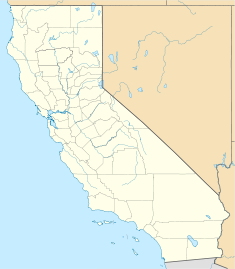The Parent Washington Navel Orange Tree is a tree grown by Eliza Tibbets in Riverside, California, in 1873. The Riverside County tree was designated a California Historic Landmark (No.20) on June 1, 1932, at the corner of Magnolia Street and Arlington Street, Riverside.[1] The Bahia, Brazil, Washington navel orange was brought to the United States by the U.S. Department of Agriculture in 1870. The Department of Agriculture imported twelve trees; from these trees, some buds were grafted on to California sweet orange trees. The Washington Navel Orange is also called California Navel Orange.[2]
| Parent Washington Navel Orange Tree | |
|---|---|
 Parent Washington Navel Orange Tree | |
| Location | Corner of Magnolia and Arlington Streets, Riverside, California |
| Coordinates | 33°56′46″N 117°24′06″W / 33.946059°N 117.401716°W |
| Built | 1873 |
| Designated | June 1, 1932 |
| Reference no. | 20 |
The navel orange is a mutation of regular sweet orange. This mutated orange was discovered in a monastery orchard in Brazil in 1820.[3] In 1870 a cutting from the navel orange was sent to Washington, D.C., thus was called the Washington navel orange. The name "navel orange" is from the mutation at the bottom blossom end of the orange. The bottom of the orange has a depression which looks like a human belly button. The mutation gives the navel orange no seeds. The Washington navel oranges were shipped all over the United States. As oranges cannot withstand freezing weather, the climate of Southern California is good for the Californian citrus industry and the navel orange.[4]
In April 2018, a white cloth was draped over the tree to prevent it from being infected by citrus greening disease. The cloth was replaced with a 22' tall x 25' x 25' tent with an insect screen in June 2019. Maintenance is the joint responsibility of UC Riverside and the City of Riverside Parks Department.[5] A 1940's era navel orange tree and grapefruit tree were also removed in April 2019 after they were found to not have significant historic value.[6]

Marker
editMarker on the Riverside, California site reads:[7]
- NO. 20 PARENT WASHINGTON NAVEL ORANGE TREE – The tree was introduced into the United States from Bahia, Brazil, by the U.S. Department of Agriculture in 1870. Twelve young trees were received and buds from them were propagated on sweet orange seedlings. In 1873 two of these greenhouse-grown trees, which were distributed throughout the United States, were sent to Mrs. Eliza Tibbets in Riverside.
See also
editReferences
edit- ^ Arellano, Gustavo (February 18, 2020). "In the Noah's Ark of citrus, caretakers try to stave off a fruit apocalypse". Los Angeles Times. Retrieved March 2, 2020.
- ^ California Parks, Parent Washington Navel Orange Tree
- ^ Parsons, Russ (February 6, 2015). "Navel oranges: full of history, flavor and uses, but not seeds". Los Angeles Times. Retrieved May 15, 2024.
- ^ Navel Orange Varieties, By Steve Albert
- ^ "Riverside's parent navel orange tree thriving under insect screen". Daily Bulletin. February 4, 2021. Retrieved September 22, 2024.
- ^ "Riverside Protecting Parent Navel Orange Tree From Citrus Greening Disease | riversideca.gov". riversideca.gov. Retrieved September 22, 2024.
- ^ californiahistoricallandmarks.com 20, Parent Washington Navel Orange Tree – Riverside
